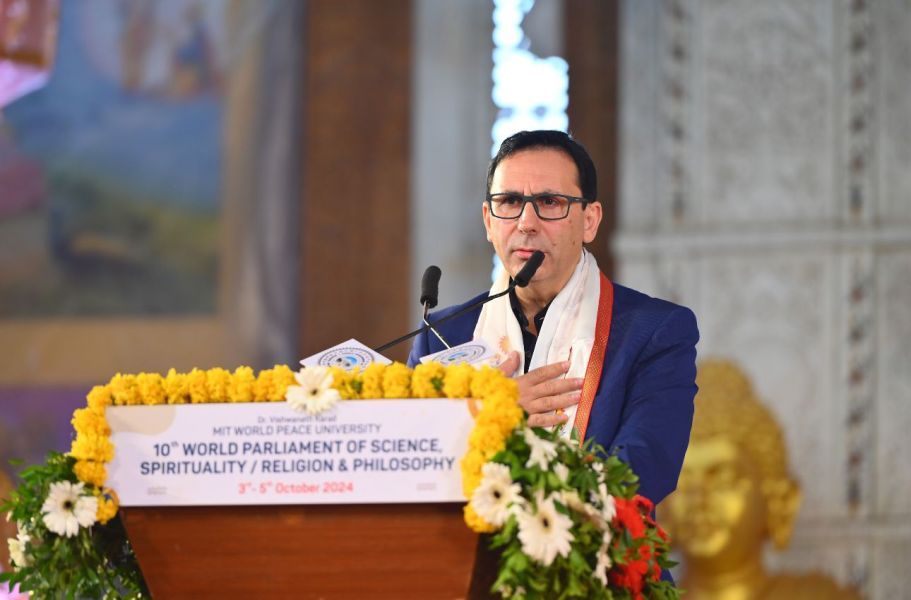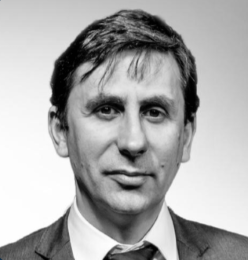Here are the excerpts of my keynote at the World Peace University on the 3d October 2024 on the occasion of the 10th World Peace Parliament of Science, Religion and Philosophy 2024: A Global Confluence for Peace and Understanding, where I presented the Peace AI Mathematical Code, a World Peace Humanity Index.

Can we create a World Peace AI Mathematical Code? A World Peace Humanity Index?
When I first met Rev. Prof. Vishwanath D Karad at Oxford Business School, his presence and the focus of his life’s work left a lasting impression on me. Being at the 10th World Peace Parliament of Science, Religion, and Philosophy 2024 serves as a moment of reflection on the role of humanity, wisdom, science, and technology.
I have been inspired by Dr Karad’s devotion to peace, science, religion and philosophy, his wonderful educational institution (MIT World Peace University), and by rethinking how important his work and The World Peace University are to the world, especially in a time that is being redesigned, as we speak, by artificial general intelligence (AGI).
During a recent conversation, Dr Karad asked whether we could create a peace formula. This is a question I have also been exploring—through research and ongoing study—towards what I call a Peace Mathematical Formula.
So how can science, technology, and AI be applied to support humanity in building such a Peace Mathematical Code? Can we create a ‘World Peace Personal and Organisational Index’?
Let us take direction from the thoughts and actions of one of the world’s most influential peace advocates, Mahatma Gandhi:
“If we are to reach real peace in this world, and if we are to carry on a real war against war, we shall have to begin with the children.” – Young India, on 19 November 1921.
“Non-violence is the first article of my faith. It is also the last article of my creed.” – A speech at Shahi Bagh on 18 March 1922, on sedition charges.
“In my humble opinion, non-cooperation with evil is as much a duty as is cooperation with good.” – Speech in Ahmedabad, 23 March 1922
According to me, peace is a simple, yet extremely powerful concept. Peace is an essential goal for the entire humanity. It has been a subject of philosophical debate, political endeavour, and academic inquiry for millennia.
However, to understand peace in a quantifiable, actionable manner, we need to go deeper in the nature of humanity.
The word peace comes from the Latin word ‘pax’. The ultimate root of pax is thought to be the Proto-Indo-European (PIE) root pak-, which means to fasten, to bind, or to agree upon. This suggests that peace, in its earliest form, was seen as a binding agreement or pact between parties to maintain harmony.
The Evolution of Humanity: Progression of Spiritual and Religious Behaviours in Society
From early times, humanity has passed through phases of growth, peace, and conflict. Modern humans, Homo sapiens, first appeared in Africa around 300,000 years ago, evolving from earlier species such as H. heidelbergensis or H. rhodesiensis, which descended from H. erectus.
By approximately 160,000 to 70,000 years ago, humans began to show behavioural modernity, with advancements in communication, tools, and cultural practices that marked the beginning of significant human development.
The origins of spirituality and religious behaviour, though difficult to date precisely, likely began during the Middle Palaeolithic era, between 45,000 and 200,000 years ago. Archaeological evidence indicates early ritualistic practices, pointing towards emerging spiritual thought.
Artefacts from the Upper Palaeolithic period (50,000–13,000 BCE) show links to early religious ideas. Objects like the lion man, Venus figurines, and the ritual burial at Sungir suggest symbolic thinking and spiritual practices among early humans.
For much of history, humans lived as hunter-gatherers until about 12,000 years ago, when the Neolithic Revolution marked a major shift. The development of agriculture began in Southwest Asia and independently occurred in regions such as Mesoamerica, China, Papua New Guinea, and parts of Africa. This shift enabled permanent settlements, the rise of complex societies, and developments in culture and technology.
Around the 4th millennium BCE, the urban revolution began, with the emergence of city-states, especially in Mesopotamia. This era saw the formation of the first known writing system, cuneiform, around 3000 BCE. Major civilisations such as Ancient Egypt and the Indus Valley Civilisation developed during this period.
The 20th century was shaped by global conflicts including two World Wars, decolonisation, and regional tensions. In the aftermath of the Second World War, while the occurrence of large-scale wars declined, global unrest persisted in different forms. Regional conflicts, financial crises, cyber challenges, misinformation, and technological disruptions continue to influence perceptions of global peace.
The World Peace Humanity Index: Balancing Science and Religion
Human nature often shifts between peaceful coexistence and conflict. Yet, science, spirituality, and religion remain important as society navigates the emergence of Artificial Intelligence (AI) and Artificial General Intelligence (AGI).
“Science without Religion (Spirituality) is lame, while Religion without Science is blind.” — Dr. Albert Einstein
Drawing on data from the past 12,000 years of human civilisation, a proposed framework—the World Peace Humanity Index—aims to integrate emotional intelligence, human ideas, and influential figures that have encouraged balance and progress.
This index will use research, history, and AI to offer insights into war, conflict, and the development of nonviolent strategies.
A challenge is extended to students and educational institutions worldwide to contribute to the creation of a Peace Mathematical Formula and Code.
Key Questions for the Present and Future:
- Can a Peace Mathematical Code be developed?
- Can a World Peace Humanity Index support and guide humanity?

Foundations for the World Peace Humanity Index with AI
As AI becomes an extension of human systems, there is an opportunity to reassess behaviours and societal design. This moment calls for a reevaluation of how we develop our human operating frameworks.
Can an AI-powered, data-driven World Peace Humanity Index be created?
Can the wisdom of history, combined with the insights of nonviolent movements and leaders like Mahatma Gandhi and Martin Luther King Jr., guide such an effort?
By analysing data on historical conflicts, causes, and patterns of peace, a mathematical model can be formed to assess and foster global stability.
Analysing War and Peace Through a Mathematical Model
The following proposed elements can be used to assess peace or conflict mathematically:

- Peace Index (P) — Measured on a scale from 0 to 1 (0 = war, 1 = peace)
- Nf: Number of nonviolent movements during a given period. A higher Nf supports peace and cooperation.
- Nc: Number of violent conflicts. A higher Nc reduces the Peace Index.
- Lr: Literacy rate and emotional intelligence. Increased Lr correlates with better conflict resolution and peaceful engagement.
- Wr: Wealth and health inequality. Wider gaps may raise conflict risks.
- Ir: Ideological rigidity. Inflexibility in beliefs can lead to unrest.
- Er: Environmental resource depletion. Resource scarcity may increase conflict.
By combining historical trends, nonviolent philosophy, and AI technology, a Global Peace Index can be built to help guide future generations in achieving social balance and harmony.
This dynamic model will not only assess current peace conditions but also predict future risks and propose strategies based on patterns of conflict and resolution.
Urgency of Peace in the AI and AGI Era
The ideas promoted by Gandhi and King reinforce the concept that peace is a deliberate, continuous commitment requiring reflection and action.
A key message from Martin Luther King Jr.’s Letter from a Birmingham Jail described the move from “a negative peace which is the absence of tension” to “a positive peace which is the presence of justice.”
The 10th World Peace Parliament of Science, Religion and Philosophy 2024 and the work of institutions such as MIT World Peace University represent steps toward building the foundation for this vision—one that must begin with individuals and educational communities.
“Success is progressive realisation of a worthy goal. It is an ongoing activity. It is an internal phenomenon. It takes struggle, hard work and honesty to be successful.” — Dr. Vijay Bhatkar
A World Peace Humanity Index, developed with AI and guided by historical insight, can enable a structured path to peace that recognises both positive and negative aspects of human nature.
It begins now: with all of us.

Dinis Guarda is an author, academic, influencer, serial entrepreneur, and leader in 4IR, AI, Fintech, digital transformation, and Blockchain. Dinis has created various companies such as Ztudium tech platform; founder of global digital platform directory openbusinesscouncil.org; digital transformation platform to empower, guide and index cities citiesabc.com and fashion technology platform fashionabc.org. He is also the publisher of intelligenthq.com, hedgethink.com and tradersdna.com. He has been working with the likes of UN / UNITAR, UNESCO, European Space Agency, Davos WEF, Philips, Saxo Bank, Mastercard, Barclays, and governments all over the world.
With over two decades of experience in international business, C-level positions, and digital transformation, Dinis has worked with new tech, cryptocurrencies, driven ICOs, regulation, compliance, and legal international processes, and has created a bank, and been involved in the inception of some of the top 100 digital currencies.
He creates and helps build ventures focused on global growth, 360 digital strategies, sustainable innovation, Blockchain, Fintech, AI and new emerging business models such as ICOs / tokenomics.
Dinis is the founder/CEO of ztudium that manages blocksdna / lifesdna. These products and platforms offer multiple AI P2P, fintech, blockchain, search engine and PaaS solutions in consumer wellness healthcare and life style with a global team of experts and universities.
He is the founder of coinsdna a new swiss regulated, Swiss based, institutional grade token and cryptocurrencies blockchain exchange. He is founder of DragonBloc a blockchain, AI, Fintech fund and co-founder of Freedomee project.
Dinis is the author of various books. He has published different books such “4IR AI Blockchain Fintech IoT Reinventing a Nation”, “How Businesses and Governments can Prosper with Fintech, Blockchain and AI?”, also the bigger case study and book (400 pages) “Blockchain, AI and Crypto Economics – The Next Tsunami?” last the “Tokenomics and ICOs – How to be good at the new digital world of finance / Crypto” was launched in 2018.
Some of the companies Dinis created or has been involved have reached over 1 USD billions in valuation. Dinis has advised and was responsible for some top financial organisations, 100 cryptocurrencies worldwide and Fortune 500 companies.
Dinis is involved as a strategist, board member and advisor with the payments, lifestyle, blockchain reward community app Glance technologies, for whom he built the blockchain messaging / payment / loyalty software Blockimpact, the seminal Hyperloop Transportations project, Kora, and blockchain cybersecurity Privus.
He is listed in various global fintech, blockchain, AI, social media industry top lists as an influencer in position top 10/20 within 100 rankings: such as Top People In Blockchain | Cointelegraph https://top.cointelegraph.com/ and https://cryptoweekly.co/100/ .
Between 2014 and 2015 he was involved in creating a fabbanking.com a digital bank between Asia and Africa as Chief Commercial Officer and Marketing Officer responsible for all legal, tech and business development. Between 2009 and 2010 he was the founder of one of the world first fintech, social trading platforms tradingfloor.com for Saxo Bank.
He is a shareholder of the fintech social money transfer app Moneymailme and math edutech gamification children’s app Gozoa.
He has been a lecturer at Copenhagen Business School, Groupe INSEEC/Monaco University and other leading world universities.









